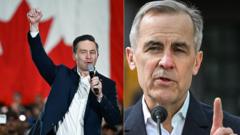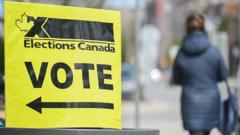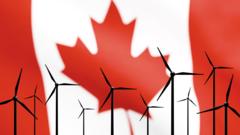As polling suggests a competitive landscape in Canada’s election, Prime Minister Mark Carney’s Liberal Party still holds a slight lead over the Conservatives led by Pierre Poilievre.
Tightening Race in Canada’s Upcoming Election: Poll Insights

Tightening Race in Canada’s Upcoming Election: Poll Insights
With Election Day approaching, the contest between the Liberal and Conservative Parties narrows.
As Canada gears up for its election on Monday, the political landscape is witnessing a narrowing gap between the two leading parties, setting the stage for a tightly contested race. Current data indicates that Prime Minister Mark Carney's Liberal Party commands a 42 percent to 39 percent lead over the Conservative Party, a notable reduction from earlier in the campaign. This shift suggests a highly dynamic voting environment, as public sentiment appears to be fluctuating.
Poll analysts like Sébastien Dallaire of Leger point out that despite the shrinking margin, the nature of vote distribution may still favor the Liberals. The intricacies of Canada's electoral system mirror some challenges seen in U.S. voting, where concentrated support for one party does not easily translate to parliamentary seats. This phenomenon could allow the Liberal Party, even in a tight national vote, to secure a majority of seats in the House of Commons.
Historically, the Conservative Party has captured the popular vote in the last two federal elections yet found itself outmaneuvered in terms of seat count, emphasizing the strategic complexities both parties face as they approach the polls. Despite the potential for declining Liberal support, the road ahead appears paved with hurdles for the Conservatives to overcome, maintaining a competitive yet uncertain electoral battleground in Canada.
Poll analysts like Sébastien Dallaire of Leger point out that despite the shrinking margin, the nature of vote distribution may still favor the Liberals. The intricacies of Canada's electoral system mirror some challenges seen in U.S. voting, where concentrated support for one party does not easily translate to parliamentary seats. This phenomenon could allow the Liberal Party, even in a tight national vote, to secure a majority of seats in the House of Commons.
Historically, the Conservative Party has captured the popular vote in the last two federal elections yet found itself outmaneuvered in terms of seat count, emphasizing the strategic complexities both parties face as they approach the polls. Despite the potential for declining Liberal support, the road ahead appears paved with hurdles for the Conservatives to overcome, maintaining a competitive yet uncertain electoral battleground in Canada.


















